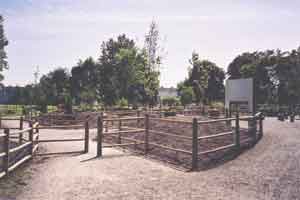|
|
|
|
REVEGETATION
MOSQUITO CREEK
| |
|

| Mosquito Creek Lane - East Bank
---- stream bank
Evergreen Foundation and City of North Vancouver
2003
Voluntary
In April 2003, neighbourhood residents and Grade 9 students from St. Thomas Aquinas Secondary School planted native plants along the east bank of Mosquito Creek between Marine Drive and Larson Road. ----- photos
|
|
| |
| |
|
Mosquito Creek experienced a dramatic loss in vegetation, from 1995 to 2000, along the bank next to the Mosquito Creek Trail. This coincided with the trail being designated "Leash Free" for dogs.
Fencing was installed in higher traffic sections to control the problem, and various areas were replanted from 2000-2002.
| |
|

| Mosquito Creek Trail Project - West Bank
---- stream bank
District of North Vancouver
2002
Voluntary
Native plants were planted.along the trail.
| |
| 
| Mosquito Creek Trail Project - West Bank
---- stream bank
City of North Vancouver
2001
Voluntary
Fencing was installed along the length of the trail. Native plants were planted.
| |
| |
| |
| 
| Mosquito Creek Trail Entry Project - West Bank
---- stream bank
City of North Vancouver
2000
Voluntary
In 1994, the dirt parking lot at the trail entry was paved and a paved cul-de-sac was put in at the top of the stream bank.
In March 2000, the cul-de-sac was moved away from the creek. About 500 square metres of asphalt pavement was removed, and replaced with berms of top soil. Native plants were planted in the summer of 2000.
|
| |
|

Mosquito Creek Park - 17th Street Trail Entry 2000
|
|

Mosquito Creek Trail - Community Planting Day 2000
|
|
| |
| |
| 
| Mosquito Creek Revegetation - West Bank
---- stream bank
City of North Vancouver
1997
Mitigation
This revegetation was part of a mitigation project, required as compensation for salmonid habitat permanently altered by construction of a commercial building next to the creek in 1997.
The riparian area from Marine Drive south to the building was planted with native plants.
|
|
| |
| |
| 
| Mosquito Creek Slope Reconstruction - East Bank
---- stream slope
City of North Vancouver
1995
Voluntary
|
|
|

Mosquito Creek - 19th Street Slope 1999
|
|
|
Prior to urban development, the original natural slope was more irregular in shape - perhaps with a small ravine along today's 19th Street.
At some point, probably in the 1950's, it was filled in with soil and built up to connect the west end of 19th and the north end of Bewicke as a continuous street.
Native plants and trees such as Big Leaf maple, cedar and hemlock grew and matured on the slope.
| |
|
In 1995, the street link between 19th and Bewicke was closed off, with the support of local residents. Over the years, it had increasingly become a short-cut for speeding drivers.
Also, the top of the slope showed signs of slumping and settling.
| |
| |
However, the city wanted to keep the area just above the slope wide enough to allow emergency vehicles through in the event that nearby streets became blocked. To do that, city staff felt that the entire slope needed to be rebuilt to improve stability.
| |
| |
In 1995, the trees and soil fill were removed, the slope was excavated and recontoured, rock fill was brought in and compacted.
| |
|
Rock fill cannot support the same type of vegetation that grew before.
So, the rock slope was covered in a thin layer of soil, then planted with grasses and wildflowers to hold the soil, and species which produce their own nitrogen - lupine and alder trees.
As alders grow bigger, their roots work down deeper into the rocks, providing nitrogen for other plant species and helping to stabilize the slope - the way nature works to revegetate barren land.
| |
|
The alder trees grew well over the next several years.
Unfortunately, at some point, someone cut down many of the alders. A little later, someone spread herbicides to kill the grasses.
Without the alders first doing their job, other plant species cannot last long on rock fill.
Without deep rooted plants, the slope is not as stable as it can be. Without grasses, topsoil can erode away.
| |
| |
Herbicides and pesticides are harmful to wildlife, and to the fish and aquatic organisms in the creek below.
| |
| |
The remaining plants continued to grow.
| |
|
|
|

